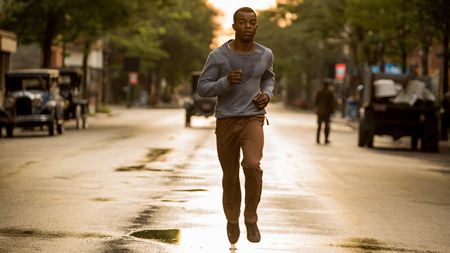Los Angeles (AP) – Stephan James is the first to acknowledge that he didn’t know much about track and field legend Jesse Owens.
The 22-year-old had to, he says, scratch his head to remember when he first heard someone was planning to make a biopic about Owens.
Not that a young Canadian actor should necessarily know details about Owens at the drop of a hat. It’s been 36 years since his death and 80 years since Owens ventured to the 1936 Summer Olympics in Berlin amid calls for a boycott and became a gold medal obstacle to Hitler’s claims of Aryan supremacy. There, as the Nazis introduced themselves on the world stage, Owens made history by winning four gold medals in track and field — a record that would stand for 48 years.
 This photo shows Stephan James as Jesse Owens in Stephen Hopkins’ “Race.” (Thibault Grabherr/Focus Features via AP)
This photo shows Stephan James as Jesse Owens in Stephen Hopkins’ “Race.” (Thibault Grabherr/Focus Features via AP)
It’s a wonder that it’s taken this long for Owens’ story to get the narrative feature treatment.
James actually found out he got the role while he was playing another pivotal figure from American history — the civil rights leader and eventual congressman John Lewis in Ava DuVernay’s “Selma.”
“He brought such sensitivity to the scenes,” recalled producer Kate Garwood, who looked at hundreds of candidates around the world to find the perfect Jesse Owens.
Knowing he’d soon have to trade his 1960s styles for some leather cleats and a dirt track, James got to work quickly, using every free day he had to go to Georgia Tech and start the process of transforming into the “fastest man alive.”
“I grew up on basketball. I was athletic but never track and field. Sprinting was a whole other beast,” James said. “Not only did I have to learn how to run fast, but I had to learn to run like Jesse. His style was so particular … his start, his mechanics, his stride, how his face looked. There are people the world over who are Jesse enthusiasts. You can’t fake that.”
By the end of training, James said he was able to run the 100-meter in just over 12 seconds. Owens broke the world record when he ran it in 10.2 seconds in 1936.
The story in “Race” stays uncommonly focused for a biopic, concentrating on a two-year stretch beginning with Owens’ start at Ohio State University and ending with the 1936 Olympics.
One of the biggest trials Owens faced during this time revolved around the question of whether he should go to Berlin at all, or stay at home in protest of the intolerant regime. In one scene in the film, NAACP leadership visits Owens and asks him to stay.
“It’s hard to relate to what Jesse could have been feeling in that moment. It blows my mind to see that his own people were pressuring him in that way not to go,” said James.
It’s no secret that he went, but his daughters told James that the conflict weighed on him.
The timing of “Race” and its not-so-oblique double entendre title and themes, seem to parallel this particular moment in the entertainment industry and the calls for more racially diverse representation and suggestions of an Oscars boycott.
But James doesn’t like to get caught up “in all of that.”
“To me it’s so much bigger than a black and a white issue, and it’s so much bigger than any one person’s opinion. We should try to find the things that unite us rather than separate us. Jesse Owens went to Berlin in 1936 and became best friends with a German long jumper. Two guys who look very different and were from very different walks of life but ended up being friends until the day Luz Long died.” James said. “I don’t feel like this film is any more or less important because it’s coming out at this time. A Jesse Owens film is always timely.”




